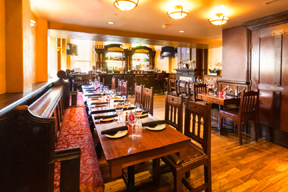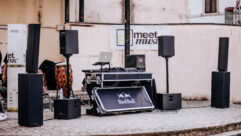
SVC Podcast – Show Notes – Show 156-1
In this edition of the SVC Podcast, SVC Contributing Editor Bennett Liles talks with Randy White of Chuck Levin’s Washington Music Center about the complete sound system design and installation done for O’Connell’s Irish Restaurant and Bar in Alexandria, Virginia. Randy outlines the decision to use Powersoft amplifiers to avoid expensive and time consuming power circuit upgrades and he discusses the control using the dbx 640 digital zone processor.
For Part 2
Links of interest:
- O’Connell’s Restaurant and Bar in Alexandria, Virginia
- Chuck Levin’s Washington Music Center
- Powersoft M28Q amplifier used for the subwoofers
- The dbx 640 digital zone processor
Download Podcast Here:
https://s3.amazonaws.com/nb-svc/public/public/156-1_OConnells_Randy_Whit…
From Sound & Video Contractor Magazine, this is the SVC Podcast with Randy White of Chuck Levin’s Washington Music Center. Show notes for the podcast are on the web site of Sound & Video Contractor Magazine at svconline.com.
One of the most popular Irish-themed night spots in the Washington, D.C. area needed a sound system that could cover the whole place and handle everything from quiet family dinner time to live bands. They called Randy White at Chuck Levin’s Washington Music Center to design it and get it all working by St. Patrick’s Day. He’s here to give us the story on how it all went, coming up right now on the SVC Podcast.
Welcome to the SVC Podcast, Randy, joining us from Maryland and Chuck Levin’s Washington Music Center. That’s actually in Wheaton, Maryland?
Wheaton, Maryland, a few minutes outside of D.C. Kind of in between Maryland, Virginia, Baltimore; kind of sitting in between. And we’re not really that far away from even West Virginia and Pennsylvania. [Timestamp: 1:09]
Yeah. Alexandria is right in your neighborhood then, and that’s the location of the big Irish restaurant and bar O’Connell’s. What sort of place is that? It looks like a nice family place but I hear they have some live music in there, too.
They could be a family place really during the day, and then in the afternoon and evenings, it becomes something completely different. It’s a traditional Irish pub and bar with prerecorded music and live music. Traditional Irish drinks and food also with a good selection of what they call craft beers now; even ones that are made in Alexandria, Virginia. You know, family dinner early, but at night it definitely takes on really kind of a different tone with different types of live music and drink specials. And the level increases significantly in the place really after 9:00 p.m. [Timestamp: 2:00]
Yes, the later it gets and on the weekends if there’s a big game or something the noise level probably goes up significantly, I would think.
Well, definitely as World Cup soccer comes on it does take on that other tone. Also they do have big screens on the premises so that they’re definitely watching. Soccer, World Cup, things like that are pretty prevalent there. Not so much with American basketball or football or other things, but really more European or Irish things like that going on. [Timestamp: 2:29]
Well, you had to cover this place with sound and make it work under all of these noise levels. From what I’ve seen, you have a lot of hard floors and a bending sort of winding floorplan with multiple levels so how are the acoustics in there? It looks like it could sound pretty live.
Actually, no. It’s amazing because all of the wood came out of like an 1800’s-century church that had closed. So you see the traditional pews and the wood is all from the church. So just because it’s an older building, the acoustics in there are almost perfect. We did very little tweaking to it. All the speakers and the power amps, Powersoft, it made such a difference that we really were able with that and the Martin speakers to be able to basically install and do very little tweaking. We didn’t have to do any kind of soundproofing. Everything worked out perfectly. As you do these for years and years sometimes you have nightmares because of the acoustics in the room. The room isn’t treated, you don’t know what the original construction was. We were really lucky that because of really the amount of wood that was in there – the wood floors and the wood bars – and everything is really finely built we didn’t have those nightmares that you would traditionally have. We were able to take and put the subwoofers hidden underneath the pews and also built into a seating area so they completely disappear so you don’t even see that the subwoofers are on premises. [Timestamp: 4:02]
That is kind of an interesting decor. They have actual church pews as a functional part of the seating area. You had to cover this whole place for live music as well as just the dining crowd. I think among other things you used a dbx 640 digital zone processor?
Well, the 640 strictly is there for easy wall plate controls. They had an existing system that was a little bit older. It was pretty much maxed out. We didn’t really need a lot of extra controls so what we did was we gave them zone control around the bar area and also the seating area. So basically the ZonePRO is really just – we’re not using any equalization processing out of it. Everything is coming through basically through the Martin processor and the amplifiers. [Timestamp: 4:50]
Okay. And when they bring in live music, how much does the setup have to change to accommodate that?
Actually it was really easy because they had been using live bands and the bands would bring their own mixer in. So when we simplified the process. We got them a nice Allen & Heath small, compact mixer. Because usually they just have trios. We built a wall plate where they plug the mixer directly into the wall plate. That feeds directly into the 640 and the 640, you can route it to where you want to route it. If you want it to go to all the areas, if you only want it to go to dining, or the main Martin system, at that point you can select where it goes. [Timestamp: 5:29]
And for amplification you decided on the Powersoft amps with I think, three different models. Were you used to using those or was it the low power consumption they’re known for?
One of the things you’re going to get with Powersoft which was amazing was, you know, we knew we were going to have limitations on power. A lot of times when you put in really high-end amplification you end up having a situation where you’re going to have to pull 20, 30 amps, 40 amps additional power. And in an older building like that, the cost to bring in an electrician and even to be lucky enough to have a circuit available becomes a completely whole other thing. So we’re really pleased that we were able to put those in there one, because of the power draw. Second, we had an amp rack that had a maximum of six spaces left because it was already full with previous other amplifiers, security things, all of that. And to be able to go in and just go okay, well we only need a couple of spaces here for these amps, two processors and we’re done. And it was simple, easy. Didn’t have to add an additional rack. We were basically plug in. We also needed an amplifier that we knew that we weren’t going to have a lot of thermal issues with. Powersoft being either high-end installations or touring amps run ice cold. This is on a third floor level where everything is centralized. There’s very little air in circulation in that room and we needed an amp that we knew that we could rely on that they weren’t going to have to put fans or air conditioning or anything on there because it’s a third floor loft. It has very little ventilation there and the amplifiers, they have them on every day, 15-16 hours a day, and they run ice cold. So it’s perfect in the sense that you don’t have these huge fans. You don’t have to worry about pulling a lot of dirt and dust inside the amplifiers. So it’s really the perfect storm for us to really use those amplifiers. The final reason was is that Martin Audio always puts in Powersoft. A lot of times they’ve rebranded it under Powersoft, but we wanted to select what amplifiers we wanted to use for what area and we needed to have something that was going to be there for 10 years that we wouldn’t have to worry about down the road. [Timestamp: 7:48]
You got the M50Q and I think the M28Q and the M14D. What does that drive, the subwoofers?
14’s are running the background. We’re running – the 28’s are running the subwoofers and the 50’s are running various speakers around the zone.
And you’ve got some subwoofers actually installed in the church pews?
We cut one of them into right next to the seat. We were looking for really kind of ideal places because when it’s a bar you don’t need to have big monster subwoofers and sometimes they’re not even on. But we needed them somewhere where they would be up and out of the way and the perfect thing was the pews are kind of elevated. They built some boxes to kind of get it up off the ground, and also so they could slide out and clean and things like that. So basically they ended up putting it in – we put them underneath two of the pews and then one additional one was put right next to a beautiful seating area. It just perfectly sat right next to the seats. The people that are sitting there, yes they’re going to get a lot of low end while they eat, but it’s a perfect location right next to where the band is playing. You could sort of see it when you’re at the bar, but you think it’s also part of the furniture. [Timestamp: 9:01]
Well that sounds good since you didn’t have to take any heroic measures for getting power to the rack. Then you don’t have a lot of fans that those speakers will have to compete with. It sounds like that rack is in a spot that’s particularly tough with the heat and where you had to put everything but it looks like it worked.
When you have an older building like that you have limitations. To turn around to an owner or to management and say we’ve got to build you another rack, I mean that office was really at its max. We could have gone with other brands of amplifiers, but I’ve got to buy a brand new rack. I’ve got to worry about where am I going to get this extra 20-30 amps of power? And everything worked out perfectly. We didn’t have to buy a new rack. We had no thermal issues. We didn’t have to add any power. The system runs probably 25-30 percent of its potential even at the maximum volume that they’re playing now. You’re barely moving the needles on any of the amplifiers there. So the system will always run extremely idle and clean. [Timestamp: 10:05]
Okay. We’re talking to Randy White of Chuck Levin’s Washington Music Center in Wheaton, Maryland about O’Connell’s Irish Restaurant in Alexandria and the new sound system. Looks like a fun place with acoustics that I thought might be a lot more challenging. In Part 2 we’ll talk about control and other things on it. Nice having you here, Randy.
Great. Thank you.
Thank you for being here with us for the SVC Podcast with Randy White. Show notes are on the website of Sound & Video Contractor Magazine at svconline.com. In Part 2 next week Randy will be telling us about the control aspect of the system and how things went when it got right down to the St. Patrick’s Day deadline. That’s on the next SVC Podcast.










